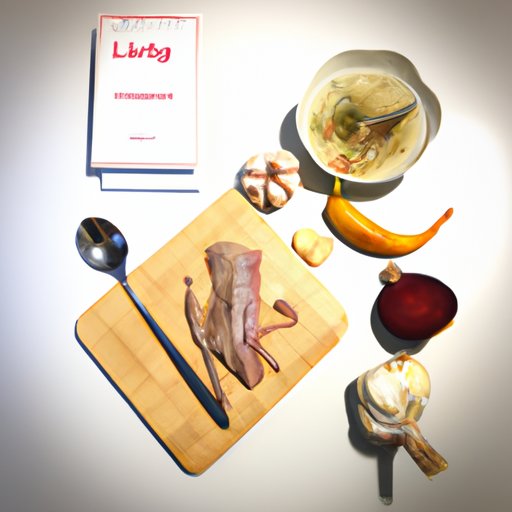Introduction
Gastritis is a medical condition that occurs when the lining of the stomach becomes inflamed. It can cause symptoms such as abdominal pain, nausea, vomiting, indigestion, and loss of appetite. While there is no one-size-fits-all diet for gastritis, there are certain foods that can help reduce symptoms and promote healing.
Creating a Gastritis-Friendly Diet: Healthy Foods to Eat
When creating a diet for someone with gastritis, it’s important to focus on foods that are easy to digest and non-irritating. Here are some healthy food options to consider:
Fruits and Vegetables
Fruits and vegetables are packed with vitamins and minerals that can help reduce inflammation in the stomach. Some good options include apples, bananas, blueberries, broccoli, carrots, spinach, and sweet potatoes. It’s best to avoid acidic fruits and vegetables such as oranges, tomatoes, and grapefruits, which can irritate the stomach.
Protein Sources
Lean proteins like chicken, fish, eggs, and tofu are great sources of essential amino acids. They also provide energy and can help build and repair muscle. If you’re looking for plant-based protein sources, beans, lentils, nuts, and seeds are all good choices.
Whole Grains
Whole grains are rich in fiber and other important nutrients. Examples include quinoa, oats, barley, and brown rice. Be sure to opt for whole grain varieties over refined grains, as they are easier to digest and contain more nutrients.
Healthy Fats
Healthy fats are essential for a balanced diet. Good sources include avocado, olive oil, nuts, and seeds. Avoid saturated and trans fats, which can be difficult to digest and can worsen symptoms of gastritis.

A Comprehensive Guide to Eating with Gastritis
Once you’ve identified the types of foods you should be eating, it’s important to know how to properly incorporate them into your diet. Here are some tips to keep in mind:
Portion Control
It’s important to pay attention to portion sizes when you have gastritis. Eating too much at once can put extra strain on your digestive system and make symptoms worse. Try to eat smaller meals throughout the day rather than large meals.
Avoiding Common Trigger Foods
Certain foods can trigger or worsen symptoms of gastritis. These include spicy foods, fried foods, processed meats, and caffeine. Limiting or avoiding these foods can help reduce symptoms.
Making Sure to Get Enough Fiber
Fiber is an important part of a healthy diet, but it can also be hard to digest for people with gastritis. Try to choose high-fiber foods that are easier to digest, such as oats and quinoa. You can also supplement with a fiber powder if needed.
The Best Foods for People with Gastritis
In addition to the above-mentioned healthy foods, there are some specific foods that may be beneficial for people with gastritis. Here are some to consider:
Fermented Foods
Fermented foods are rich in probiotics, which can help balance the gut bacteria and reduce inflammation. Examples include yogurt, kefir, sauerkraut, kimchi, and kombucha.
Probiotic Foods
Probiotic foods are foods that contain live cultures of beneficial bacteria. This includes yogurt, kefir, and fermented vegetables. Eating probiotic foods can help restore balance to the digestive system and reduce symptoms of gastritis.
Non-Acidic Beverages
Most beverages are acidic and can aggravate symptoms of gastritis. Stick to non-acidic options like herbal tea, decaffeinated coffee, and water. Avoid carbonated beverages, alcohol, and sugary drinks.
10 Delicious Meals for Gastritis Sufferers
Eating a healthy diet doesn’t have to be boring. Here are some delicious meal ideas that are perfect for people with gastritis:
Breakfast Ideas
- Overnight oats with banana and almond butter
- Scrambled eggs with steamed spinach and mushrooms
- Smoothie bowl with chia seeds and berries
Lunch Ideas
- Quinoa salad with roasted vegetables and chickpeas
- Vegetable soup with lentils and brown rice
- Turkey sandwich on whole wheat bread with lettuce and tomato
Dinner Ideas
- Grilled salmon with roasted potatoes and asparagus
- Stir-fried vegetables with tofu and brown rice
- Vegetable lasagna with whole wheat noodles and ricotta cheese

What to Avoid When You Have Gastritis
In addition to avoiding common trigger foods, there are some other items you should avoid when you have gastritis. These include:
Spicy Foods
Spicy foods can irritate the stomach and worsen symptoms of gastritis. Try to limit or avoid spicy foods such as chili peppers, hot sauce, and curry.
Caffeine
Caffeine can cause stomach irritation and increase acid production, so it’s best to avoid it if you have gastritis. Stick to decaffeinated coffee and tea, or try herbal teas instead.
Alcohol
Alcohol can irritate the stomach lining and worsen symptoms of gastritis. It’s best to avoid alcohol altogether if possible.

How to Heal Gastritis Through Diet Changes
Making dietary changes is one of the most effective ways to heal gastritis. Here are some tips to get you started:
Eating Smaller Portions
Eating smaller portions can help reduce the strain on your digestive system and give your body time to heal. Try to stick to three small meals per day, with snacks in between if necessary.
Limiting Processed and Refined Foods
Processed and refined foods can be difficult to digest and can worsen symptoms of gastritis. Try to stick to whole, unprocessed foods as much as possible.
Drinking Plenty of Water
Staying hydrated is important for overall health, and it can also help reduce symptoms of gastritis. Aim to drink at least 8 glasses of water per day.
Conclusion
Gastritis can be a difficult condition to manage, but making the right dietary changes can help reduce symptoms and promote healing. By focusing on fruits and vegetables, lean proteins, whole grains, and healthy fats; limiting common trigger foods; and drinking plenty of water, you can create a gastritis-friendly diet that works for you.
(Note: Is this article not meeting your expectations? Do you have knowledge or insights to share? Unlock new opportunities and expand your reach by joining our authors team. Click Registration to join us and share your expertise with our readers.)
